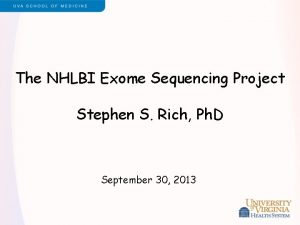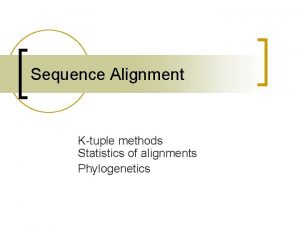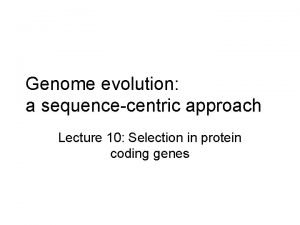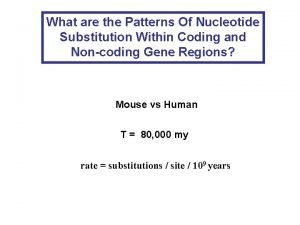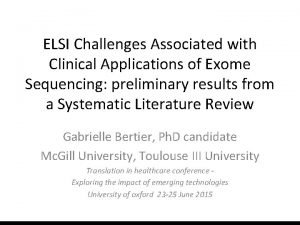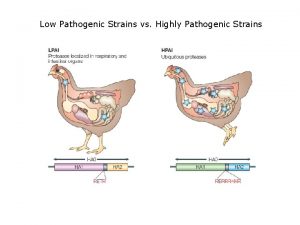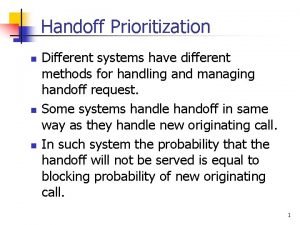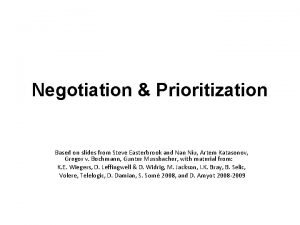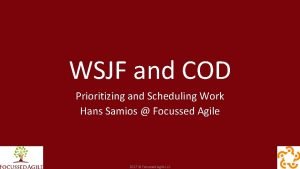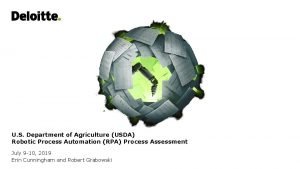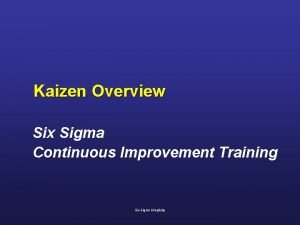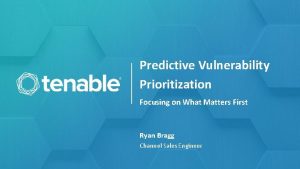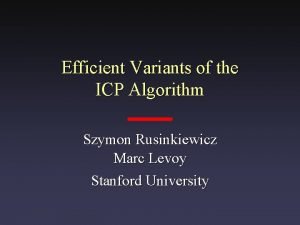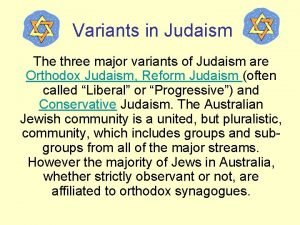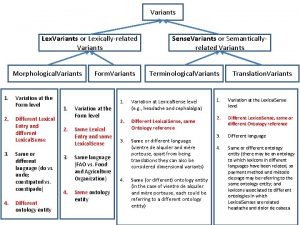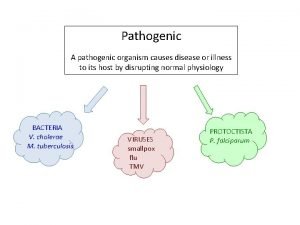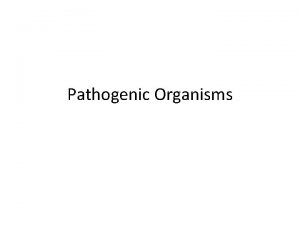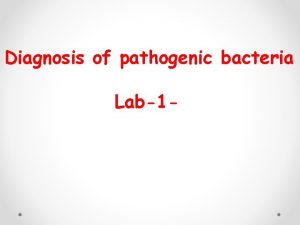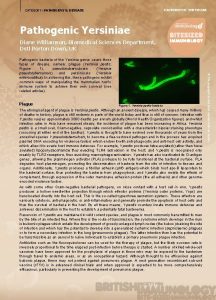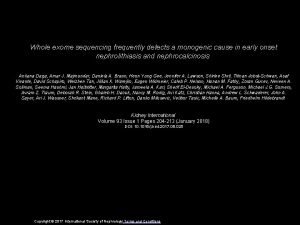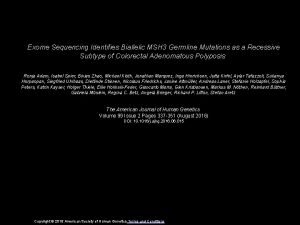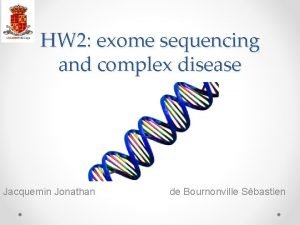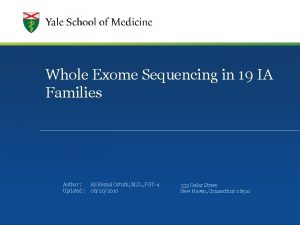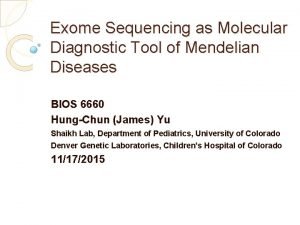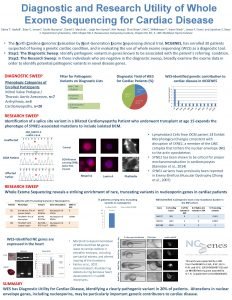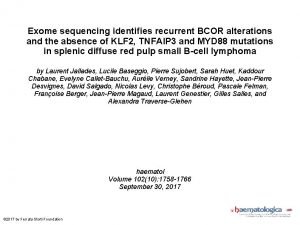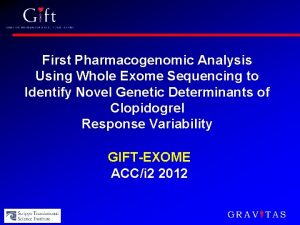Pathogenic prioritization of nonsynonymous variants in exome sequencing

![Non-synonymous variants [ns. SNPs] (Mutations altering amino acids) • Not equally important Deleterious: affecting Non-synonymous variants [ns. SNPs] (Mutations altering amino acids) • Not equally important Deleterious: affecting](https://slidetodoc.com/presentation_image_h2/30797aec8c63ef3fd8ea837f6377f796/image-2.jpg)




















- Slides: 22

Pathogenic prioritization of nonsynonymous variants in exome sequencing studies Miaoxin Li IBG 2015 Centre for Genomics Sciences & Department of Psychiatry The University of Hong Kong mxli@hku. hk
![Nonsynonymous variants ns SNPs Mutations altering amino acids Not equally important Deleterious affecting Non-synonymous variants [ns. SNPs] (Mutations altering amino acids) • Not equally important Deleterious: affecting](https://slidetodoc.com/presentation_image_h2/30797aec8c63ef3fd8ea837f6377f796/image-2.jpg)
Non-synonymous variants [ns. SNPs] (Mutations altering amino acids) • Not equally important Deleterious: affecting functions of proteins Being pathogenic: causing a disease Neutral: The more deleterious, higher pathogenic potential

General principle of deleteriousness prediction

Procedure for deleterious ns. SNPs vv vv Wu and Jiang (2012)The Scientific World Journal Volume 2013, Article ID 675851

Tools for deleteriousness prediction Dong et al. Human Molecular Genetics, 2015, 1– 13 doi: 10. 1093/hmg/ddu 733

Spearman's rank correlation matrix for the scores

Inconsistent prediction Reference. Alter Polyphen 2_HDI Polyphen 2_HV native. Allele Gene. Symbol V_pred AR_pred Start. Position 8 133251794 A/C KCNQ 3 D; D D D medium 1 68669602 G/C RPE 65 B B N D low 17 7517842 A/G TP 53 P; P; D; P N D medium 18 45817276 C/T MYO 5 B B; P B; B D D medium 10 127412194 C/T C 10 orf 137 D; D; D; P D D low 3 170968107 C/T ACTRT 3 D D N D high D: porobably damaging, P: possibly damaging, B: benign, N: neutral predicted functional (high, medium), predicted non-functional (low, neutral) LRT_pred Mutation. Taster Mutation. Asses _pred sor_pred Chromosome

Distinguishing pathogenic ns. SNVs from other rare ns. SNVs FATHMM receiver operating characteristic (ROC) curve

Solution? --Combined prediction • Logistic regression model Benchmark dataset 5, 340 disease-causal alleles vs. 4, 752 rare non-disease-causal ns. SNVs Li et al. PLo. S Genet. 2013; 9(1): e 1003143.

Criticisms • Related but not straightforward for pathogenicity • Maybe ineffective for unknown pathogenic mutations

db. NSFP database (v 2. 9) • Pre-compute scores • Over 13 deleteriousness or conservation prediction tools • 87 347 044 possible ns. SNPs in the wholeexome

Practical with KGGSeq Genotypes In VCF/Pileup format Statistic summaries from Plink/Seq Public domain knowledge in databases Users’ knowledge on diseases/traits Pipelines on KGGSeq A biological Knowledge-based mining system/platform for Genomic and Genetic studies using Sequence data Seq Prioritized annotated variants Li et al. Nucleic Acids Res. 2012 Apr 1; 40(7): e 53

A multilayer automated filtration and prioritization framework Variants and/or genotypes called from sequencing data in variants formats Exclude variants outside identity by descent (IBD) regions Genetic level Exclude variants conflicting with disease inheritance patterns/modes Exclude common variants (e. g. , MAF 0. 001) in db. SNP, 1 K Genome Project and other datasets Exclude variants not altering proteins Known disease genes Variant level Exclude predicted non-disease variants Disease names Knowledge level Explore variants whose genes have physical protein-protein interaction with candidate genes Explore variants whose genes share the same biological pathways with candidate genes Explore available literature in NCBI Pub. Med about genes/ideogram and interested diseases Prioritized annotated variants in an Excel or text file Li MX, Gui HS, Kwan SH, Bao SY, Sham PC. A comprehensive framework for prioritizing variants in exome sequencing studies of Mendelian diseases. Nucleic Acids Research (Nucleic Acids Res. 2012 Apr 1; 40(7): e 53)

Li et al. Hum Mutat. 2015 Feb 10. doi: 10. 1002/humu. 22766. [Epub ahead of print]

Why do we need kggseq? • Help you filter, prioritize and annotate sequence variants to identify disease-causal mutations • Advantage: integrative

Gene feature annotation by KGGSeq, ANNOVAR and VEP based on Ref. Gene database in an exome sequencing dataset of 66, 272 called variants KGGSeq vs. ANNOVAR KGGSeq vs. VEP overlapped ANNOVAR Unique (#db. SNP) KGGSeq Unique (#db. SNP) overlapped VEP Unique (#db. SNP) 22(14) a 13 0 22(11) 13 2(1) stopgain 4(3) 75 1(0) b 15(11) 64 7(1) missense 199(128) 9210 0 1550(1345) 7856 114(43) synonymous 112(77) 10129 16(12) 1637(1204) 8604 92(26) splicing 3(1) 81 0 49(20) 35 1564(123) KGGSeq Unique (#db. SNP) stoploss vv vv #db. SNP: The number of variants supported by annotations in db. SNP. However, it should be noted that variants without support from db. SNP are not necessarily incorrect. a: This includes some variants which have reversed reference and alternative alleles. b: This is actually a stopgain mutation by an 1 -bp deletion frameshift, so it could be a frameshift as well. TNNI 3: NM_000363(7 Exons)

The number of retained sequence variants by KGGSeq in the Neonatal-onset Crohn disease sample Functions Initial Quality control on genotype and variants levels Inheritance pattern Rare in db. SNP + 1000 Genome + ESPb Not altering amino acid c Super-duplicate regions d Predicted to be non-pathogenic Hitting both copies of a gene #Sequence variants De-novo mutation Double-hit gene 1, 196, 282 68992 197 a 133 7 1 0 - – 1325 253 228 171 3 e Note: a: the de-novo mutation based inheritance model filtration removes all sequence variants at which alleles of a child are present in his or her parents; b The rare variants referred to variants with MAF 3% in the datasets; c: this category includes missense, stopgain, stoploss and splicing single nucleotide variants and insertions/deletions causing frameshift, nonframeshift, stoploss, stopgain and splicing differences; d: variants in putative genomic duplications defined in a dataset (genomic. Super. Dups) from UCSC (http: //hgdownload. cse. ucsc. edu/golden. Path/hg 19/database/genomic. Super. Dups. txt. gz ), which have higher genotyping error rate (http: //blog. goldenhelix. com/? p=1153); e: double-hit gene filtration function it to only retain variants at which each parent has transmitted at least one mutation in the same gene to the child.

The number of retained sequence variants by KGGSeq in a dominant mode Functions Initial Quality control on genotype and variants levels Inheritance patterna Filter all variants in reference database Rare in db. SNP + 1000 Genome + ESPb Protein altering variantsc Super-duplicate regions d Over 4 variants within the same gene Predicted to be non-pathogenic Spinocerebellar ataxias 1, 417, 935 82543 21122 268 248 39 36 17 17 Familial spastic paraplegia 1, 017, 018 84119 937 74 69 4 4 4 3 Notes: a: dominant mode only considered variants in heterozygous genotypes and with shared alleles between the two patients; b: The rare variants referred to variants with MAF 1% in the datasets; c: this category includes missense, stopgain, stoploss and splicing single nucleotide variants and insertions/deletions causing frameshift, nonframeshift, stoploss, stopgain and splicing differences d: variants in putative genomic duplications defined in a dataset (genomic. Super. Dups) from UCSC (http: //hgdownload. cse. ucsc. edu/golden. Path/hg 19/database/genomic. Super. Dups. txt. gz), which have higher genotyping error rate (http: //blog. goldenhelix. com/? p=1153). Spinocerebellar ataxias Familial spastic paraplegia

Key functions of the three tools for filtration, prioritization and annotation KGGSeq Systematic QC on genotype, variant and subject levels Recessive, dominant compound heterozygous, de novo and runs of homozygosity. ANNOVAR (Version 2) Only by depth and sequencing quality Too simple, cannot directly take genotypes of controls; it only works for recessive and dominant modes VEP No Variants reference databases db. SNP, 1000 Genomes Project and ESP Similar to w. KGGSeq Gene annotation Ref. Gene GENCODE UCSC known. Gene ENSEMBL Ref. Gene Functional prediction SLR SIFT Polyphen 2_HDIV Polyphen 2_HVAR LRT Mutation. Taster Mutation. Assessor FATHMM_score CADD_score GERP++_NR GERP++_RS Phylo. P 100 way_vertebrate 29 way_log. Odds Yes Ref. Gene GENCODE UCSC known. Gene ENSEMBL Same as w. KGGSeq No No Quality control Use disease mode Protein-protein interaction and pathway Literature Management of input data Disease-targeted prioritization Pub. Med Yes No SIFT Polyphen 2_HDIV Polyphen 2_HVAR

The summary filtration and prioritization results of three tools in three pedigrees KGGSeq ANNOVAR VEP Neonatal-onset Crohn disease Initial variants Retained variants when the causal mutations were kept finally Variant hit by PPIs, pathways or Pub. Med search Additional evidences to highlight the causal mutations 1196282 68992 a 3 53 4232 PPI+Pathway+Pub. Med - - Spinocerebellar ataxias Initial variants Retained variants when the causal mutations were kept finally Variant hit by PPIs, pathways or Pub. Med search Additional evidences to highlight the causal mutations 1417935 82465 a 17 29 6501 3 - - Pathway+PPI - - Familial spastic paraplegia Initial variants Retained variants when the causal mutations were kept finally Variant hit by PPIs, pathways or Pub. Med search 1017018 63207 a 3 7 5109 2 - - Note: a: as w. ANNOVAR cannot effectively map variants on VCF data, KGGSeq was used to do the basic quality control on VCF data of affected samples.

Main inputs of KGGSeq Sequence variants in VCF format ##fileformat=VCFv 4. 1 ##file. Date=20090805 ##source=my. Imputation. Program. V 3. 1 ##reference=file: ///seq/references/1000 Genomes. Pilot-NCBI 36. fasta ##contig=<ID=20, length=62435964, assembly=B 36, md 5=f 126 cdf 8 a 6 e 0 c 7 f 379 d 618 ff 66 beb 2 da, species="Homo sapiens", taxonomy=x> ##phasing=partial ##INFO=<ID=NS, Number=1, Type=Integer, Description="Number of Samples With Data"> ##INFO=<ID=DP, Number=1, Type=Integer, Description="Total Depth"> ##INFO=<ID=AF, Number=A, Type=Float, Description="Allele Frequency"> ##INFO=<ID=AA, Number=1, Type=String, Description="Ancestral Allele"> ##INFO=<ID=DB, Number=0, Type=Flag, Description="db. SNP membership, build 129"> ##INFO=<ID=H 2, Number=0, Type=Flag, Description="Hap. Map 2 membership"> ##FILTER=<ID=q 10, Description="Quality below 10"> ##FILTER=<ID=s 50, Description="Less than 50% of samples have data"> ##FORMAT=<ID=GT, Number=1, Type=String, Description="Genotype"> ##FORMAT=<ID=GQ, Number=1, Type=Integer, Description="Genotype Quality"> ##FORMAT=<ID=DP, Number=1, Type=Integer, Description="Read Depth"> ##FORMAT=<ID=HQ, Number=2, Type=Integer, Description="Haplotype Quality"> #CHROM POS ID REF ALT QUAL FILTER INFO FORMAT NA 00001 NA 00002 NA 00003 20 14370 rs 6054257 G A 29 PASS NS=3; DP=14; AF=0. 5; DB; H 2 GT: GQ: DP: HQ 0|0: 48: 1: 51, 51 1|0: 48: 8: 51, 51 1/1: 43: 5: . , . 20 17330. T A 3 q 10 NS=3; DP=11; AF=0. 017 GT: GQ: DP: HQ 0|0: 49: 3: 58, 50 0|1: 3: 5: 65, 3 0/0: 41: 3 20 1110696 rs 6040355 A G, T 67 PASS NS=2; DP=10; AF=0. 333, 0. 667; AA=T; DB GT: GQ: DP: HQ 1|2: 21: 6: 23, 27 2|1: 2: 0: 18, 2 2/2: 35: 4 20 1230237. T. 47 PASS NS=3; DP=13; AA=T GT: GQ: DP: HQ 0|0: 54: 7: 56, 60 0|0: 48: 4: 51, 51 0/0: 61: 2 20 1234567 microsat 1 GTC G, GTCT 50 PASS NS=3; DP=9; AA=G GT: GQ: DP 0/1: 35: 4 0/2: 17: 2 1/1: 40: 3 Sequence variants in ANNOVAR format Chr Start Ref Obs Comments 1 161003087 End C T a 1 84647761 C T b 1 1 13133880 11326183 13133881 11326183 TC - AT v f 1 105293754 A ATAAA d

Let’s start the practical • Follow the instructions • Everything can be found in the online user manual • The short tutorial will help you known what you are doing Question!
 Exome sequencing project
Exome sequencing project Synonymous vs nonsynonymous mutation
Synonymous vs nonsynonymous mutation Synonymous vs nonsynonymous mutation
Synonymous vs nonsynonymous mutation Synonymous vs nonsynonymous mutation
Synonymous vs nonsynonymous mutation Exome
Exome Non pathogenic definition
Non pathogenic definition Low pathogenic avian influenza
Low pathogenic avian influenza Prioritization
Prioritization Risk prioritization in software engineering
Risk prioritization in software engineering Damian2005 trick
Damian2005 trick Abcd prioritization nursing
Abcd prioritization nursing Ticket prioritization
Ticket prioritization Project intake process presentation
Project intake process presentation Wsjf score
Wsjf score Program prioritization process
Program prioritization process Rpa prioritization matrix
Rpa prioritization matrix Infrastructure project prioritisation matrix
Infrastructure project prioritisation matrix Delegation matrix
Delegation matrix Kaizen overview
Kaizen overview Priorizatio
Priorizatio Efficient variants of the icp algorithm
Efficient variants of the icp algorithm Luke gill
Luke gill Jewish variants
Jewish variants
